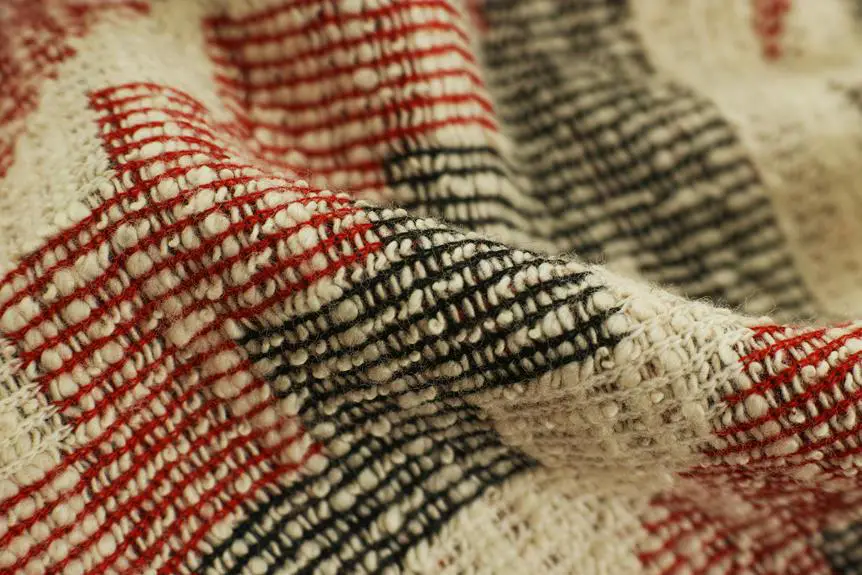When you think about choosing between pinpoint and flannel, you're looking at two fabrics that serve very different purposes. Pinpoint, with its crisp finish, is your go-to for those formal occasions where a polished look matters. On the other hand, flannel's cozy texture makes it perfect for laid-back environments. Understanding these key differences can significantly influence your wardrobe choices, but the nuances don't stop there. What happens when you consider weight, texture, and care? The implications may surprise you.
Table of Contents
Fabric Composition and Structure
When comparing pinpoint and flannel, you'll notice distinct differences in their fabric composition and structure.
Pinpoint fabric is made from tightly woven cotton or a cotton blend, featuring a smooth, crisp finish. This structure gives it a polished look, ideal for dress shirts and formal wear. The weave is finer and denser, which enhances its durability and resistance to wrinkling.
On the other hand, flannel is typically crafted from brushed cotton or a wool blend, resulting in a soft, fuzzy texture. This loose weave allows for breathability and warmth, making it perfect for casual wear, especially in colder months. Flannel's composition often includes a slight nap, giving it that cozy, inviting feel that many love.
The contrasting structures also impact how each fabric drapes. Pinpoint holds its shape well, while flannel tends to be more relaxed and flowy.
When you choose between these two, consider the occasion and comfort level you desire, as each fabric serves a unique purpose in your wardrobe. Understanding these differences will help you make an informed decision for your clothing needs.
Weight and Thickness Comparison
You'll find that pinpoint and flannel differ significantly in weight and thickness, impacting their overall feel and suitability for various occasions.
Pinpoint fabric is typically lighter and thinner, making it a great choice for warmer weather or formal settings where breathability is key. Its lightweight nature allows for easy layering without adding bulk to your outfit.
On the other hand, flannel is thicker and heavier, providing warmth and comfort that's perfect for cooler temperatures or casual wear. This added thickness makes flannel ideal for cozy settings, such as lounging at home or enjoying a chilly evening outdoors.
Here are a few key points to consider:
- Pinpoint: Lightweight and breathable, ideal for summer or formal events.
- Flannel: Heavier and warmer, perfect for cold weather and casual occasions.
When choosing between the two, think about the weather and the setting. Your choice can enhance your comfort and style, ensuring you feel your best no matter the occasion.
Texture and Feel
Pinpoint fabric offers a smooth, crisp texture that feels sleek against the skin, while flannel boasts a soft, fuzzy feel that envelops you in warmth. When you touch pinpoint, you'll notice its polished surface, which gives it a refined and sophisticated vibe. This makes it an excellent choice for formal and professional settings, where a clean, tailored look is essential.
On the other hand, flannel's cozy, brushed texture invites comfort and relaxation. You'll likely find it perfect for casual wear or lounging at home, wrapping you in a gentle embrace. The thickness of flannel adds to its plush feel, making it an ideal choice during colder months when you crave extra warmth.
The choice between these two fabrics ultimately depends on the experience you want. If you desire a sleek, polished finish, pinpoint is your go-to. However, if you prefer a comforting, snuggly sensation, flannel is the way to go.
Both fabrics offer unique textures that cater to different moods and occasions, allowing you to express your personal style while prioritizing comfort.
Common Uses and Applications
Commonly found in dress shirts and tailored suits, pinpoint fabric is ideal for formal occasions where a sophisticated appearance is essential. Its smooth texture and subtle sheen make it a popular choice for professional settings, ensuring you look polished and put-together.
You'll often see pinpoint fabric in the following applications:
- Business Attire: Pinpoint shirts pair well with blazers and trousers, providing a refined look for meetings, interviews, or corporate events.
- Weddings and Formal Events: Its elegant finish makes it a favorite for groomsmen's attire and other formal gatherings, helping you stand out without being overly flashy.
While pinpoint is perfect for these occasions, flannel, with its cozy texture, suits more relaxed settings.
Understanding when to use pinpoint versus flannel ensures you're dressed appropriately for any event, balancing comfort with style.
Keep these common applications in mind when you're choosing your next outfit!
Care and Maintenance Tips
Caring for your pinpoint and flannel garments properly ensures they maintain their appearance and longevity, so knowing the right maintenance tips is key.
For pinpoint shirts, always check the care label before washing. Typically, machine wash in cold water on a gentle cycle to prevent fading and shrinking. Avoid bleach, and tumble dry on low; if you can, air-dry to keep the fabric crisp. Iron on a medium setting to remove wrinkles, and you'll keep that sharp look.
Flannel, on the other hand, requires a bit more attention. Wash your flannel items in cold water, as hot water can cause shrinkage. Use a mild detergent to protect the soft texture. While you can tumble dry on low, air-drying is preferable to maintain the flannel's cozy feel. If you need to iron, do so on a low setting with steam to avoid flattening the fabric.
Both fabrics benefit from occasional professional cleaning, especially for stubborn stains.
Frequently Asked Questions
What Are the Historical Origins of Pinpoint and Flannel Fabrics?
You'll find that pinpoint fabric originated in the 19th century from cotton, while flannel dates back to Wales in the 17th century, evolving from wool. Both have rich histories influencing their popularity in modern textiles.
How Do Pinpoint and Flannel Fabrics Impact the Environment?
When considering environmental impact, you'll find that pinpoint fabrics often use less water and energy during production, while flannel, typically made from cotton, can involve more intensive farming practices. Both have sustainability challenges worth exploring.
Are There Any Notable Fashion Trends Featuring Pinpoint or Flannel?
You'll notice that pinpoint shirts are popular for polished looks, while flannel dominates casual styles. Both fabrics have unique places in fashion trends, appealing to different tastes and occasions, enhancing your wardrobe versatility.
Which Fabric Is More Suitable for Formal Occasions?
When choosing fabric for formal occasions, pinpoint's smooth texture and crisp appearance make it a better fit. It elevates your look, whereas flannel's casual vibe isn't quite suitable for more sophisticated events.
Can Pinpoint and Flannel Be Blended With Other Materials?
Yes, you can blend pinpoint and flannel with other materials. Combining them with cotton or polyester enhances durability and versatility, making your garments suitable for various occasions while maintaining comfort and style.
- How Does Ring Spun Cotton Affect Garment Fit and Shape Retention? - August 13, 2024
- What Are the Challenges in Producing Ring Spun Cotton? - August 13, 2024
- Is Ring Spun Cotton Suitable for Plus-Size Clothing? - August 13, 2024







